Navigation
Oceana discovers one of the most important and threatened deep-sea coral reefs of the Mediterranean in the Alboran Sea
Oceana has discovered large colonies of white coral and a wealth of associated fauna in Spanish waters of the Alboran Sea (Western Mediterranean), with greater abundance at depths between 300 and 500 meters.
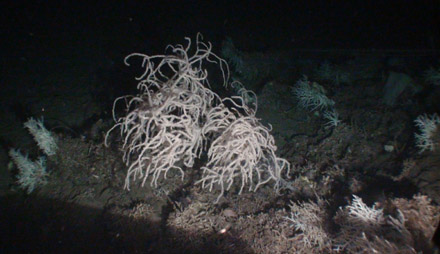 |
| Black coral (Antipathes dichotoma). This picture and the other photographs in this article were taken by a ROV (Remote Operated Vehicle) at depths lower than 300 meters.Expedition Oceana Ranger 2010: Discovering seamounts. Seco de los Olivos, Almeria, Spain. June 2010. Photograph copyright Oceana |
See Video: Deep-sea corals below at the bottom of the article or click on the title. All pictures were taken by a ROV (Remote Operated Vehicle) at depths lower than 300 meters.
Oceana has discovered large colonies of white coral and a wealth of associated fauna in Spanish waters of the Alboran Sea (Western Mediterranean), with greater abundance at depths between 300 and 500 meters. The finding took place during the 2010 expedition of the research catamaran, the Oceana Ranger, as part of LIFE+ INDEMARES project. Given this habitat’s importance for numerous species and its poor state of conservation, Oceana is requesting measures to protect it.
Findings such as the coral reef of Santa María di Leuca in Italy or the canyons of Creus and Palamós in Catalonia have increased hope in the possible existence of yet to be discovered deep-sea coral reefs. This new reef found in Alboran is one of the most important ones in the Mediterranean, but also of the most threatened ones. This is because most of the colonies are dead or are endangered by the fishing activities that go on in the area.
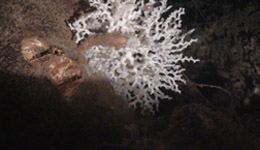 |
| Deep-sea white coral (Madrepora oculata). Expedition Oceana Ranger 2010: Discovering seamounts. Seco de los Olivos, Almeria, Spain. June 2010. Photograph copyright Oceana |
Live colonies of deep-sea coral coexist with large expanses of dead coral. The coral that still survives suffers accelerated deterioration that is threatening one of this sea’s richest ecosystems. White coral is intertwined with black coral, whip coral, glass sponges and other species that dwell at these depths to make up a habitat of great importance to species such as redfish, roughy, and red seabream.
It is believed that half of the white coral reefs in the Atlantic have disappeared, and in the Mediterranean, the situation seems to be worse. Most of the research conducted to date has only found dead coral that must have formed large reefs at the bottom of the sea long ago.
Oceana has sounded the alarm to increase the size and number of marine protected areas in order to prevent the heavy retreat of the most vulnerable ecosystems in the Mediterranean such as the coral reefs, the maërl beds, coralligenous communities, forests of laminarian and fucoid algae, etc.
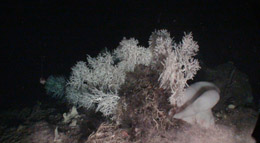 |
| Deep sea white coral (Madrepora oculata) and glass sponge (Asconema setubalense). Expedition Oceana Ranger 2010: Discovering seamounts. Seco de los Olivos, Almeria, Spain. June 2010. Photograph copyright Oceana |
LIFE+ INDEMARES project is aimed at contributing to the protection and sustainable use of the marine biodiversity of the Spanish seas by studying 10 marine areas to garner information about their natural value, and eventually, propose them to be part of the marine Natura 2000 Network.
The Mediterranean continues to suffer a large number of threats due to the high number of human activities that take place there; destructive fishing, seacoast destruction, shipping, polluting spills, exploitation of gas and oil or climate change are taking their toll on this sea that still shelters a rich biodiversity and some of the most spectacular ecosystems on the planet.
“It is painful to see that there is a greater volume of dead than live coral. If the living colonies that we have found are already spectacular in and of themselves, you would have to imagine what these magnificent reefs attained before they deteriorated,” declares Ricardo Aguilar, Director of Research for Oceana Europe.
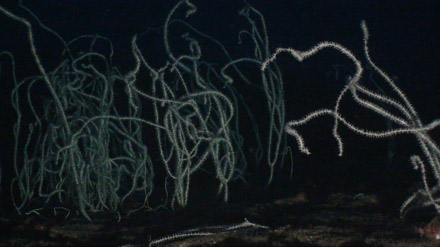 |
| Gorgonians (Viminella flagellum). Deep-sea coral reefs have already disappeared from most of the Mediterranean. Expedition Oceana Ranger 2010: Discovering seamounts. Seco de los Olivos, Almeria, Spain. June 2010. Photograph copyright Oceana |
Ignacio Torres, Director of Studies and Projects at Biodiversity Foundation, pointed out that “these findings confirm the relevance and good opportunity of the INDEMARES Project. The information that is currently being collected will serve to improve the marine resources protection and sustainable use, being this one the spirit leading the activities of all project members”.
Coral reefs are considered as habitats of Community interest by the Habitats Directive whereby the Member States, Spain being one of them, must create marine protected areas to conserve them. The recent evaluation of the compliance status of the said directive for the marine environment has made the noticeable lack of protection for these places abundantly clear. It is therefore urgent and necessary to protect them immediately. The LIFE+ INDEMARES project is aimed at complying with this requirement by identifying valuable areas to be included in the Natura 2000 Network.
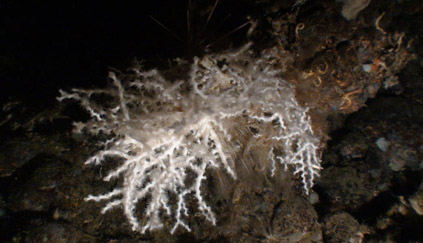 |
| Deep-sea white coral (Madrepora oculata). Given this habitat’s importance for numerous species and its poor state of conservation, Oceana is requesting measures to protect it. A large part of the reef has been lost through the use of different fishing gear such as bottom trawling and longline fishing, but there are still extensive areas of white coral at a depth of over 300 meters. Expedition Oceana Ranger 2010: Discovering seamounts. Seco de los Olivos, Almeria, Spain. June 2010.Photograph copyright Oceana |
Coordinated by Biodiversity Foundation (Fundación Biodiversidad), the project will have a participatory approach, and will include all of the relevant institutions in management, research and conservation in marine environments: Environmental, Rural and Marine Affairs Ministry (through the Secretary General of Sea Affairs), the Spanish Institute of Oceanography (IEO), the Spanish Council for Scientific Research, ALNITAK, the Coordinator for the Study of Marine Mammals, OCEANA, the Society for the Study of Cetaceans in the Canary Archipelago, SEO/BirdLife and WWF Spain.
The project actions will be carried out from January 1st, 2009 to December 31st, 2013. The total budget is € 15.4 million, and the European Commission will co-finance 50% of the project.
Onboard log of the Oceana Ranger’s 2010 Expedition
See Video: Deep-sea corals below at the bottom of the article or click on the title.
Note:
The Biodiversity Foundation (Fundación Biodiversidad) is a public foundation of Spain’s Ministry of Environment and Rural and Marine Affairs. The Foundation’s mission is to preserve natural heritage and promote biodiversity conservation, with special attention to rural areas. The Foundation funds conservation projects in Spain and internationally. The activities of the Biodiversity Foundation are organized around five strategies:
- Conservation of natural heritage and biodiversity;
- Sustainable development of rural areas;
- The fight against climate change;
- Marine conservation;
- International cooperation.
This news is from Oceana.
Corales de profundidad | © OCEANA from Oceana on Vimeo.
Search
Latest articles
Agriculture
- World Water Week: Healthy ecosystems essential to human health: from coronavirus to malnutrition Online session Wednesday 24 August 17:00-18:20
- World Water Week: Healthy ecosystems essential to human health: from coronavirus to malnutrition Online session Wednesday 24 August 17:00-18:20
Air Pollution
- "Water and Sanitation-Related Diseases and the Changing Environment: Challenges, Interventions, and Preventive Measures" Volume 2 Is Now Available
- Global Innovation Exchange Co-Created by Horizon International, USAID, Bill and Melinda Gates Foundation and Others
Biodiversity
- It is time for international mobilization against climate change
- World Water Week: Healthy ecosystems essential to human health: from coronavirus to malnutrition Online session Wednesday 24 August 17:00-18:20
Desertification
- World Water Week: Healthy ecosystems essential to human health: from coronavirus to malnutrition Online session Wednesday 24 August 17:00-18:20
- UN Food Systems Summit Receives Over 1,200 Ideas to Help Meet Sustainable Development Goals
Endangered Species
- Mangrove Action Project Collaborates to Restore and Preserve Mangrove Ecosystems
- Coral Research in Palau offers a “Glimmer of Hope”
Energy
- Global Innovation Exchange Co-Created by Horizon International, USAID, Bill and Melinda Gates Foundation and Others
- Wildlife Preservation in Southeast Nova Scotia
Exhibits
- Global Innovation Exchange Co-Created by Horizon International, USAID, Bill and Melinda Gates Foundation and Others
- Coral Reefs
Forests
- NASA Satellites Reveal Major Shifts in Global Freshwater Updated June 2020
- Global Innovation Exchange Co-Created by Horizon International, USAID, Bill and Melinda Gates Foundation and Others
Global Climate Change
- It is time for international mobilization against climate change
- It is time for international mobilization against climate change
Global Health
- World Water Week: Healthy ecosystems essential to human health: from coronavirus to malnutrition Online session Wednesday 24 August 17:00-18:20
- More than 400 schoolgirls, family and teachers rescued from Afghanistan by small coalition
Industry
- "Water and Sanitation-Related Diseases and the Changing Environment: Challenges, Interventions, and Preventive Measures" Volume 2 Is Now Available
- Global Innovation Exchange Co-Created by Horizon International, USAID, Bill and Melinda Gates Foundation and Others
Natural Disaster Relief
- STOP ATTACKS ON HEALTH CARE IN UKRAINE
- Global Innovation Exchange Co-Created by Horizon International, USAID, Bill and Melinda Gates Foundation and Others
News and Special Reports
- World Water Week: Healthy ecosystems essential to human health: from coronavirus to malnutrition Online session Wednesday 24 August 17:00-18:20
- STOP ATTACKS ON HEALTH CARE IN UKRAINE
Oceans, Coral Reefs
- World Water Week: Healthy ecosystems essential to human health: from coronavirus to malnutrition Online session Wednesday 24 August 17:00-18:20
- Mangrove Action Project Collaborates to Restore and Preserve Mangrove Ecosystems
Pollution
- Zakaria Ouedraogo of Burkina Faso Produces Film “Nzoue Fiyen: Water Not Drinkable”
- "Water and Sanitation-Related Diseases and the Changing Environment: Challenges, Interventions, and Preventive Measures" Volume 2 Is Now Available
Population
- "Water and Sanitation-Related Diseases and the Changing Environment: Challenges, Interventions, and Preventive Measures" Volume 2 Is Now Available
- "Water and Sanitation-Related Diseases and the Changing Environment: Challenges, Interventions, and Preventive Measures" Volume 2 Is Now Available
Public Health
- Honouring the visionary behind India’s sanitation revolution
- Honouring the visionary behind India’s sanitation revolution
Rivers
- World Water Week: Healthy ecosystems essential to human health: from coronavirus to malnutrition Online session Wednesday 24 August 17:00-18:20
- Mangrove Action Project Collaborates to Restore and Preserve Mangrove Ecosystems
Sanitation
- Honouring the visionary behind India’s sanitation revolution
- Honouring the visionary behind India’s sanitation revolution
Toxic Chemicals
- "Water and Sanitation-Related Diseases and the Changing Environment: Challenges, Interventions, and Preventive Measures" Volume 2 Is Now Available
- Actions to Prevent Polluted Drinking Water in the United States
Transportation
- "Water and Sanitation-Related Diseases and the Changing Environment: Challenges, Interventions, and Preventive Measures" Volume 2 Is Now Available
- Urbanization Provides Opportunities for Transition to a Green Economy, Says New Report
Waste Management
- Honouring the visionary behind India’s sanitation revolution
- Honouring the visionary behind India’s sanitation revolution
Water
- Honouring the visionary behind India’s sanitation revolution
- Honouring the visionary behind India’s sanitation revolution
Water and Sanitation
- Honouring the visionary behind India’s sanitation revolution
- Honouring the visionary behind India’s sanitation revolution

